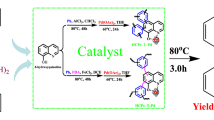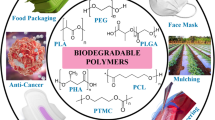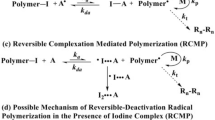Abstract
A novel, microwave safe and recyclable polymeric reagent was prepared by anchoring bromoderivative of 2-pyrrolidone in the polymer matrix of 3% tetraethyleneglycol diacrylate cross-linked polystyrene. The synthetic utility of the prepared polymeric reagent was demonstrated by the efficient bromination of unsaturated compounds, activated aromatic compounds and also for the α-bromination of ketones under microwave activation. Operational simplicity, moderate to excellent yield of the products, shorter reaction time and dry reaction medium are the foremost attraction of this protocol. Moreover, the synthesized functional polymer was stable under standard laboratory conditions and can be kept for several months without any significant loss of activity.
Graphic abstract











Similar content being viewed by others
References
Saikia I, Borah AJ, Phukan P (2016) Use of bromine and bromo-organic compounds in organic synthesis. Chem Rev 116(12):6837–7042. https://doi.org/10.1021/acs.chemrev.5b00400
Smith K (1995) Advances in organobromine chemistry II. Elsevier, New York, pp 4–64
Vanotterlo W (2004) Unforeseen formation of 2-bromo-3-hydroxybenzaldehyde by bromination of 3-hydroxybenzaldehyde. Tetrahedron Lett 45:5091–5094. https://doi.org/10.1016/s0040-4039(04)01010-x
El-Hamshary H, Selim AI, Salahuddin NA, Mandour HS (2015) Clay–polymer nanocomposite-supported brominating agent. Clays Clay Miner 63(4):328–336. https://doi.org/10.1346/ccmn.2015.0630406
Rogers JV, Price JA, Wendling MQS, Perry MR, Reid FM, Kiser RC, Graham JS (2011) An assessment of transcriptional changes in porcine skin exposed to bromine vapor. J Biochem Mol Toxicol 25(4):252–262. https://doi.org/10.1002/jbt.20383
Narender N, Krishna Mohan KV, Reddy RV, Srinivasu P, Kulkarni S, Raghavan K (2003) Liquid phase bromination of phenols using potassium bromide and hydrogen peroxide over zeolites. J Mol Catal A Chem 192(1–2):73–77. https://doi.org/10.1016/s1381-1169(02)00131-0
Tajik H, Mohammadpoor-Baltork I, Albadi J (2007) Bromination of some aromatic compounds with potassium bromide in the presence of benzyltriphenylphosphonium peroxodisulfate. Synth Commun 37(2):323–328. https://doi.org/10.1080/00397910601033906
Adibi H, Hajipour AR, Hashemi M (2007) A convenient and regioselective oxidative bromination of electron-rich aromatic rings using potassium bromide and benzyltriphenylphosphonium peroxymonosulfate under nearly neutral reaction conditions. Tetrahedron Lett 48(7):1255–1259. https://doi.org/10.1016/j.tetlet.2006.12.033
Stropnik T, Bombek S, Kočevar M, Polanc S (2008) Regioselective bromination of activated aromatic substrates with a ZrBr 4/diazene mixture. Tetrahedron Lett 49(11):1729–1733. https://doi.org/10.1016/j.tetlet.2008.01.07
Khansole SV, Patwari SB, Vibhute AY, Vibhute B (2009) Isoquinolinium bromochromate: an efficient and stable reagent for bromination of hydroxylated aromatic compounds and oxidation of alcohols. Chin Chem Lett 20(3):256–260. https://doi.org/10.1016/j.cclet.2008.11.015
Borikar SP, Daniel T, Paul V (2009) An efficient, rapid, and regioselective bromination of anilines and phenols with 1-butyl-3-methylpyridinium tribromide as a new reagent/solvent under mild conditions. Tetrahedron Lett 50(9):1007–1009. https://doi.org/10.1016/j.tetlet.2008.12.053
Zupan M, Segatin N (1994) Bromination of organic molecules with polymer-supported bromine complexes. Synth Commun 24(18):2617–2626. https://doi.org/10.1080/00397919408010574
Lakouraj MM, Tajbakhsh M, Mokhtary M (2005) Poly(vinylpyrrolidone)-bromide complex; a mild and efficient reagent for selective bromination of alkenes and oxidation of alcohols. J Chem Res 8:481–483. https://doi.org/10.3184/030823405774663246
Koshy EP, Zacharias J, Rajasekharan Pillai VN (2006) Poly (N-vinylpyrrolidone)-hydrotribromide: a new gel type resin for alcohol oxidation ad alkene dibromination. React Funct Polym 66(8):845–850. https://doi.org/10.1016/j.reactfunctpolym.2005.11.0
Mokhtary M, Lakouraj MM (2011) Polyvinylpolypyrrolidone–bromine complex: mild and efficient polymeric reagent for bromination of activated aromatic compounds. Chin Chem Lett 22(1):13–17. https://doi.org/10.1016/j.cclet.2010.06.002
Mokhtary M, Lakouraj MM (2012) Polyvinylpyrrolidone-bromine complex: An efficient polymeric reagent for selective preparation of benzyl bromides in the presence of hexamethyldisilane. Bull Chem Soc Ethiop 26(2):305–309. https://doi.org/10.4314/bcse.v26i2.14
EI-Hamshary H, Selim AI, Salahuddin NA, Mandour HS, (2015) Clay–polymer nanocomposite-supported brominating agent. Clays Clay Miner 63(4):328–336. https://doi.org/10.1346/ccmn.2015.0630406
Mokhtary M (2018) Recent advances in synthetic applications of polyvinyl pyrrolidone supported reagents and catalysts. Acad J Polym Sci 2(1):555580. https://doi.org/10.19080/AJOP.2018.02.555580
Hodge P (1997) Polymer-supported organic reactions: What takes place in the beads? Chem Soc Rev 26:417–424. https://doi.org/10.1039/CS9972600417
Trost BM, Warner RW (1982) Macrocyclization via an isomerization reaction at high concentrations promoted by palladium templates. J Am Chem Soc 104(22):6112–6114. https://doi.org/10.1021/ja00386a045
Trost BM, Keinan E (1978) Steric steering with supported palladium catalysts. J Am Chem Soc 100(24):7779–7781. https://doi.org/10.1021/ja00492a084
Shuttleworth SJ, Allin SM, Wilson RD, Nasturica D (2000) Functionalised polymers in organic chemistry; part 2. Synthesis 8:1035–1074. https://doi.org/10.1055/s-2000-6310
McNamara CA, Dixon MJ, Bradley M (2002) Recoverable catalysts and reagents using recyclable polystyrene-based supports. Chem Rev 102:3275–3300. https://doi.org/10.1021/cr0103571
Hajjami M, Ghorbani-Choghamarani A, Norouzi M (2012) An efficient and facile procedure for synthesis of acetates from alcohols catalyzed by poly(4-vinylpyridinium tribromide). Chin J Catal 33(9–10):1661–1664. https://doi.org/10.1016/s1872-2067(11)60441-5
Ghorbani-Choghamarani A, Azadi G (2011) Polyvinylpolypyrrolidone-supported hydrogen peroxide (PVP-H2O2), silica sulfuric acid and catalytic amounts of ammonium bromide as green, mild and metal-free oxidizing media for the efficient oxidation of alcohols and sulphides. J Iran Chem Soc 8(4):1082–1090. https://doi.org/10.1007/bf03246566
Ghorbani-choghamarani A, Pourbahar N (2012) Polyvinylpolypyrrolidoniume tribromide as an efficient catalyst for the acetylation of alcohols and phenols. Chin J Catal 33(9–10):1470–1473. https://doi.org/10.1016/s1872-2067(11)60428-2
Veerakumar P, Lu ZZ, Velayudham M, Lu KL, Rajagopal S (2010) Alumina supported nanoruthenium as efficient heterogeneous catalyst for the selective H2O2 oxidation ofaliphatic and aromatic sulfides to sulfoxides. J Mol Catal A Chem 332:128–137. https://doi.org/10.1016/j.molcata.2010.09.008
Akelah A (1988) The use of functionalised polymers as polymeric reagents in solid phase organic synthesis—a review. React Polym Ion Exch Sorb 8(3):273–284. https://doi.org/10.1016/0167-6989(88)90303-0
Takemoto K, Inaki Y, Ottenbrite RM (1987) Functional monomers and polymers. Dekker, New York, pp 1–100
Thomas JM (1999) Design, synthesis, and in situ characterization of new solid catalysts. Angew Chem Int Ed 38(24):3588–3628. https://doi.org/10.1002/(sici)1521-3773(19991216)38:24%3c3588::aid-anie3588%3e3.0.co;2-4
De la Hoz A, Loupy A (2013) Microwaves in organic synthesis, 3rd edn. Wiley, Weinheim
Jaśkowska J, Drabczyk A, Kułaga D, Zaręba P, Majka Z (2018) Solvent-free microwave-assisted synthesis of aripiprazole. Curr Chem Lett 7(3):81–86. https://doi.org/10.5267/j.ccl.2018.08.002
Ramírez JR, Caballero R, Guerra J, Ruiz-Carretero A, Sánchez-Migallón A, de la Hoz A (2015) Solvent-free microwave-assisted synthesis of 2, 5-dimethoxyphenylaminotriazines. ACS Sustain Chem Eng 3(12):3405–3411. https://doi.org/10.1021/acssuschemeng.5b0113
Kamil F, Abid Hubeatir K, Shamel M, Al-Amiery AA (2015) Microwave-assisted solvent-free synthesis of new polyimine. Cogent Chem. https://doi.org/10.1080/23312009.2015.1075853
Patel JP, Avalani JR, Raval DK (2013) Polymer supported sulphanilic acid: a highly efficient and recyclable green heterogeneous catalyst for the construction of 4,5-dihydropyrano[3,2-c]chromenes under solvent-free conditions. J Chem Sci 125(3):531–536. https://doi.org/10.1007/s12039-013-0408-8
De la Hoz A, Díaz-Ortis A, Moreno A (2000) Langa F (2000) Cycloadditions under microwave irradiation conditions: methods and applications. Eur J Org Chem 22:3659–3673
Subodh G, Deepu V, Mohanan P, Sebastian MT (2009) Polystyrene/Sr2Ce2Ti5O15composites with low dielectric loss for microwave substrate applications. Polym Eng Sci 49(6):1218–1224. https://doi.org/10.1002/pen.21220
O’Keefe S, Luscombe CK (2016) Microwave dielectric properties of polytetrafluoroethylene-polyacrylate composite films made via aerosol deposition. Polym Int 65(7):820–826. https://doi.org/10.1002/pi.5138
Sherrington DC, Hodge P (1980) polymer supported reactions in organic synthesis. Wiley, New York
Arunan C, Pillai VNR (2003) 1,6-hexanediol diacrylate-crosslinked polystyrene: Preparation, characterization, and application in peptide synthesis. J Appl Polym Sci 87(8):1290–1296. https://doi.org/10.1002/app.11538
Marvel CS, Porter PK (1941) Organic synthesis collection, vol 1, 2nd edn. Wiley, New York
Saju M. Sebastian (2013) Microwave assisted reactions using polyvinylpyrrolidone supported reagents. Dissertation, Mahatma Gandhi University, Kottayam, Kerala, India
Renil M, Rajasekharan Pillai VN (1996) Synthesis, characterization and application of tetraethylene glycol diacrylate crosslinked polystyrene support for gel phase peptide synthesis. J Appl Polym Sci 61:1585–1594. https://doi.org/10.1002/(sici)1097-4628(19960829)61:9%3c1585::aid-app18%3e3.0.co;2-p
Kumar KS, Rajasekharan Pillai VN (1999) Synthesis of peptide-N-alkylamides on a new PS-TTEGDA polymer support using photolabile anchoring group. Tetrahedron 55:10437–10446. https://doi.org/10.1016/s0040-4020(99)00569-4
Zhao HC, Guo JL, Li JT, Gao LL, Bian CC (2010) Synthesis and thermal property of linear chloromethylated polystyrene. Adv Mater Res 150–151:1504–1507. https://doi.org/10.4028/www.scientific.net/amr
Acknowledgements
The financial assistance to Anjaly Mathew from University Grants Commission, Government of India, under minor research project, is gratefully acknowledged. The authors would like to thank SAIF STIC, CUSAT, Kerala, India, for characterization facilities.
Funding
This work was supported by the University Grants Commission Government of India, under Minor Research Project. [No. 2265-MRP /15-16/KLCA029/UGC-SWRO dated 25th April 2016].
Author information
Authors and Affiliations
Contributions
All authors contributed to the study conception and design. Material preparation, data collection and analysis were performed by AM, BM and EPK. The first draft of the manuscript was written by AM, and all authors commented on previous versions of the manuscript. All authors read and approved the final manuscript.
Corresponding author
Ethics declarations
Conflict of interest
The authors declare that they have no conflict of interest.
Additional information
Publisher's Note
Springer Nature remains neutral with regard to jurisdictional claims in published maps and institutional affiliations.
Supplementary Information
Below is the link to the Supplementary Information.
Rights and permissions
About this article
Cite this article
Mathew, A., Mathew, B. & Koshy, E.P. Polystyrene-supported bromoderivative of 2-pyrrolidone: synthesis, characterization and application in microwave-assisted bromination reactions. Polym. Bull. 79, 905–920 (2022). https://doi.org/10.1007/s00289-021-03540-0
Received:
Revised:
Accepted:
Published:
Issue Date:
DOI: https://doi.org/10.1007/s00289-021-03540-0




